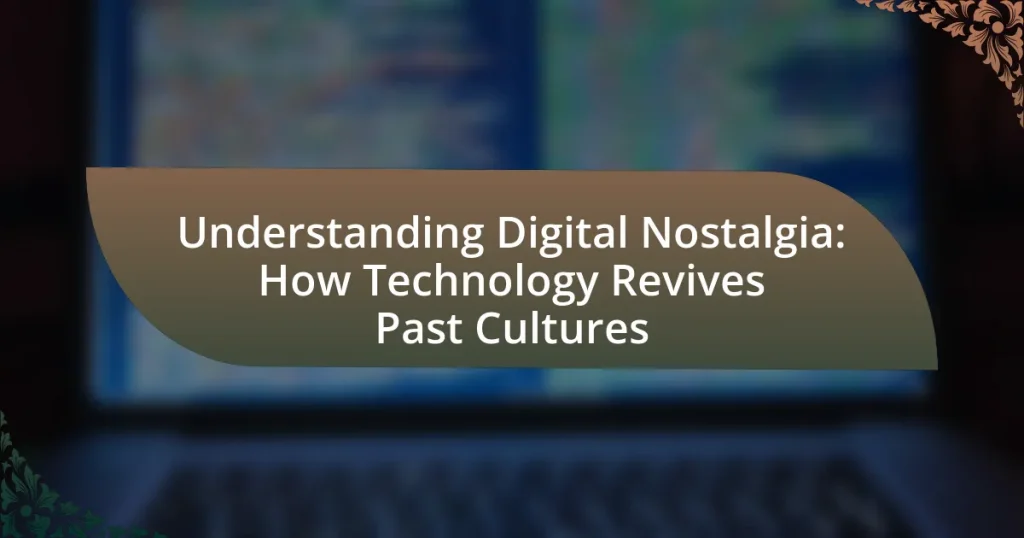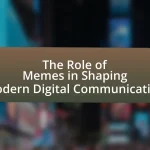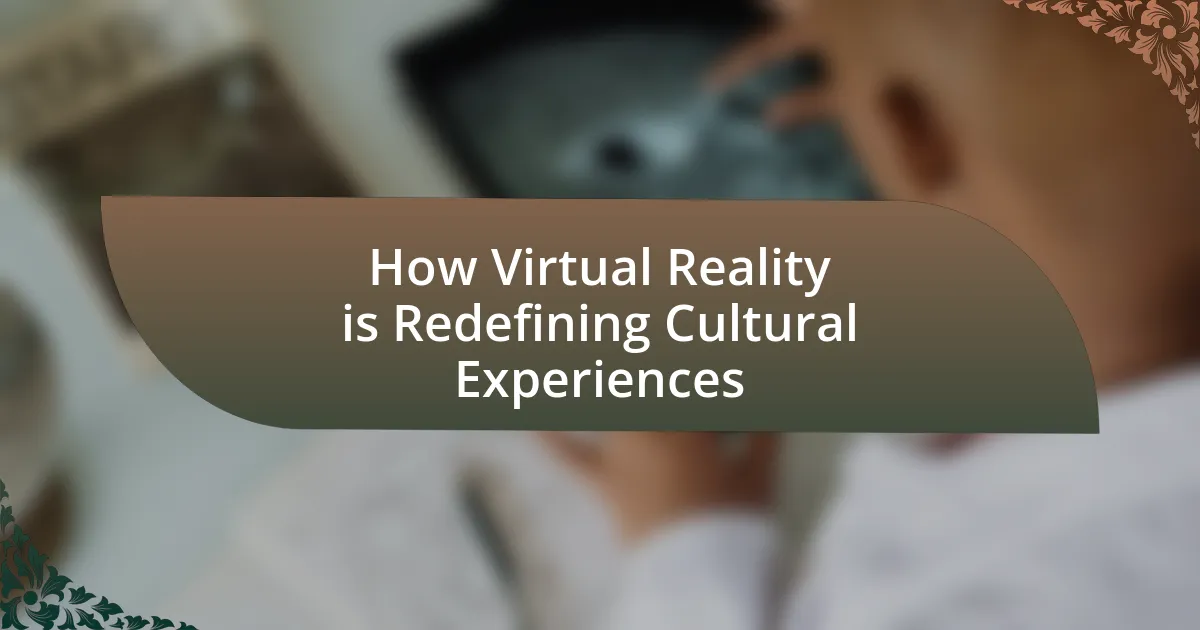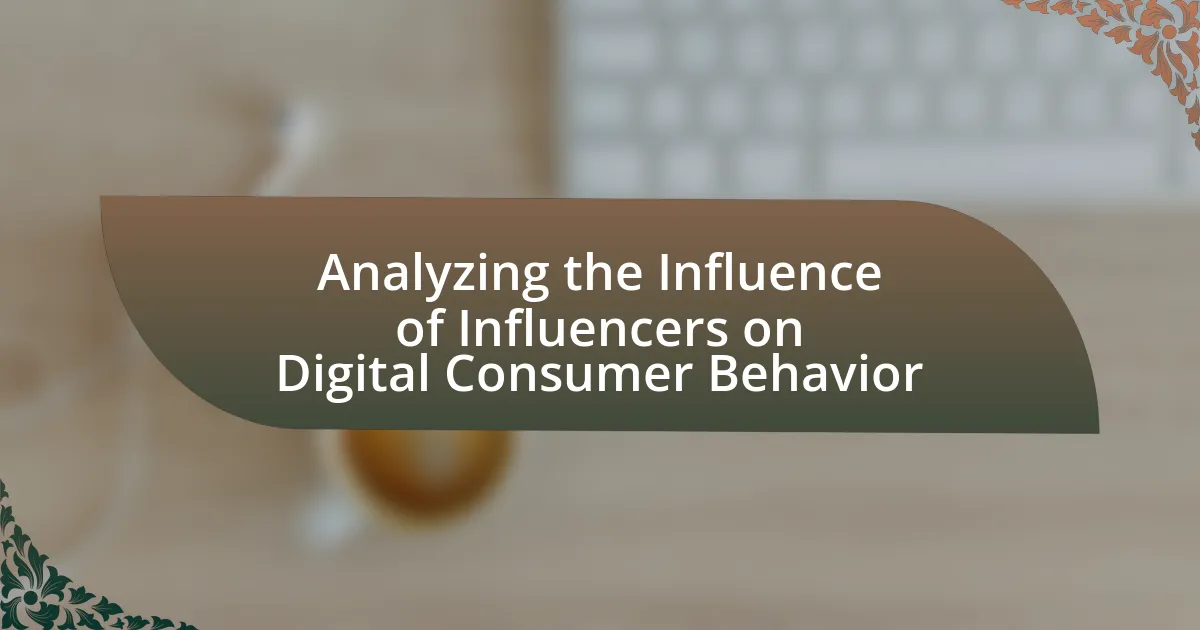Digital nostalgia refers to the emotional longing for the past, often triggered by digital media and technology, such as retro video games and vintage social media platforms. This phenomenon enhances user engagement and fosters community connections, particularly through the resurgence of 80s and 90s pop culture on platforms like Instagram and TikTok. The article explores how digital nostalgia manifests in contemporary culture, its psychological effects, and its significance in shaping social interactions and consumer behavior. It also examines the role of technology and social media in preserving cultural memories, the potential drawbacks of idealizing the past, and practical steps individuals can take to engage positively with digital nostalgia.
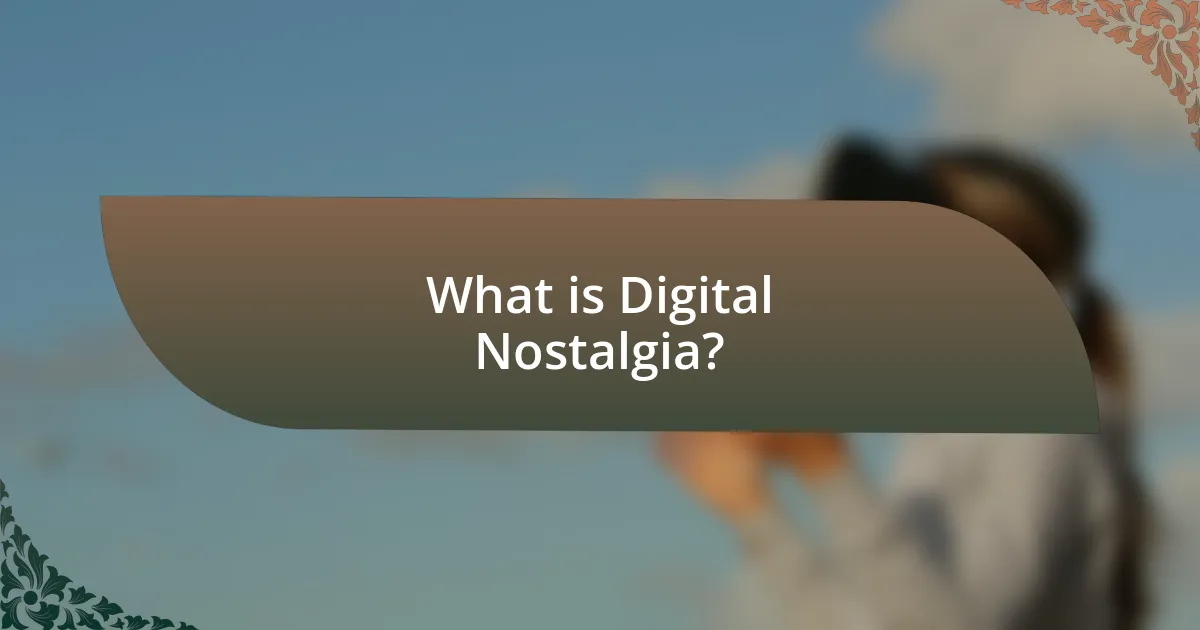
What is Digital Nostalgia?
Digital nostalgia is the emotional longing for the past that is often triggered by digital media and technology. This phenomenon occurs when individuals engage with digital artifacts, such as retro video games, vintage social media platforms, or classic films, which evoke memories and feelings associated with earlier times. Research indicates that digital nostalgia can enhance user engagement and foster community connections, as seen in the resurgence of interest in 80s and 90s pop culture through platforms like Instagram and TikTok, where users share and celebrate nostalgic content.
How does Digital Nostalgia manifest in contemporary culture?
Digital nostalgia manifests in contemporary culture through the revival of retro aesthetics, the resurgence of vintage media formats, and the integration of past cultural references in modern technology. This phenomenon is evident in the popularity of 8-bit video games, vinyl records, and the use of retro design elements in apps and websites. For instance, platforms like Instagram and TikTok often feature filters and effects that mimic the look of older film and photography styles, appealing to users’ longing for the past. Additionally, the success of reboots and remakes of classic films and television shows, such as “Stranger Things,” highlights how contemporary audiences are drawn to familiar narratives and styles from previous decades. This trend is supported by research indicating that nostalgia can enhance emotional well-being and foster social connections, making it a powerful tool in marketing and content creation.
What are the key characteristics of Digital Nostalgia?
Digital nostalgia is characterized by a longing for past experiences and cultural artifacts that are often revived through technology. This phenomenon manifests in various forms, including the resurgence of retro video games, vintage aesthetics in design, and the revival of past music genres through streaming platforms. The emotional connection to these past experiences is often intensified by the accessibility of digital media, allowing individuals to relive and share memories associated with earlier cultural moments. Additionally, digital nostalgia can foster community among users who share similar memories, as seen in online forums and social media groups dedicated to specific eras or cultural phenomena.
How does Digital Nostalgia differ from traditional nostalgia?
Digital nostalgia differs from traditional nostalgia primarily in its reliance on technology and digital media to evoke memories. While traditional nostalgia often stems from physical artifacts, such as photographs or music records, digital nostalgia is facilitated by online platforms, social media, and digital archives that allow for instant access to past experiences. For example, the resurgence of retro video games and the sharing of vintage content on platforms like Instagram and TikTok illustrate how digital mediums can amplify nostalgic feelings by creating a communal experience around shared memories. This technological aspect enables a more immediate and widespread engagement with nostalgia, contrasting with the more personal and solitary nature of traditional nostalgia.
Why is Digital Nostalgia significant in today’s society?
Digital nostalgia is significant in today’s society because it fosters a sense of connection and identity among individuals through shared memories of past cultural experiences. This phenomenon is amplified by technology, which enables the revival and accessibility of retro media, such as video games, music, and television shows, that evoke fond memories. For instance, the resurgence of 80s and 90s pop culture in contemporary media, including remakes and reboots, highlights how digital platforms can reignite interest in previous eras, creating community among fans. Studies indicate that engaging with nostalgic content can enhance emotional well-being, as it allows individuals to reflect on positive experiences and connect with others who share similar backgrounds.
What psychological effects does Digital Nostalgia have on individuals?
Digital nostalgia can evoke a range of psychological effects on individuals, including increased feelings of happiness, connection, and identity reinforcement. Research indicates that engaging with nostalgic content can enhance mood and provide comfort by allowing individuals to reminisce about positive past experiences. For instance, a study published in the journal “Emotion” by Wildschut et al. (2006) found that nostalgia can foster social connectedness and improve self-esteem, as individuals often recall shared experiences with loved ones. Additionally, digital nostalgia can lead to a sense of belonging and continuity in one’s life narrative, as it helps individuals integrate their past with their present identity.
How does Digital Nostalgia influence social interactions?
Digital nostalgia influences social interactions by fostering connections through shared memories and experiences from the past. This phenomenon encourages individuals to engage in conversations about their collective history, often facilitated by social media platforms that allow users to reminisce about cultural artifacts, such as music, movies, and games from their youth. Research indicates that nostalgia can enhance social bonding; for instance, a study published in the Journal of Personality and Social Psychology found that nostalgic recollections can increase feelings of social connectedness and improve mood, thereby promoting more meaningful interactions among individuals.
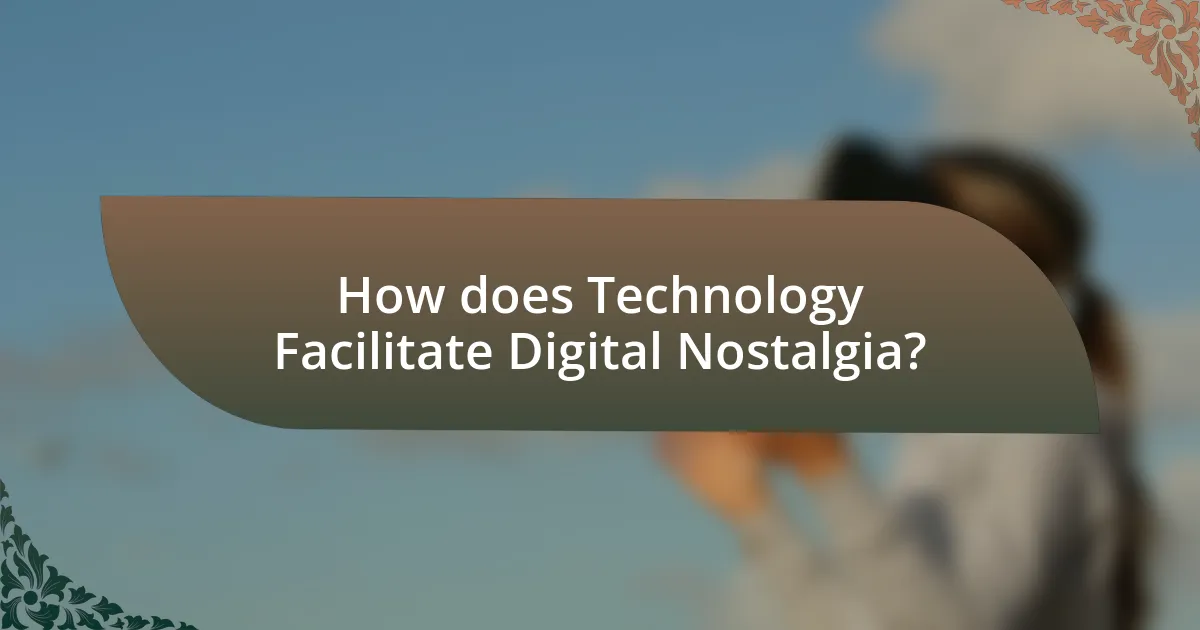
How does Technology Facilitate Digital Nostalgia?
Technology facilitates digital nostalgia by enabling the preservation and sharing of past experiences through various digital mediums. Digital platforms, such as social media, allow users to reminisce by sharing photos, videos, and memories from their past, creating a collective experience that evokes nostalgia. Additionally, advancements in virtual reality and augmented reality provide immersive experiences that recreate historical environments or moments, further enhancing the emotional connection to the past. Research indicates that the use of digital archives and online communities fosters a sense of belonging and connection to shared histories, reinforcing the nostalgic experience.
What role do social media platforms play in reviving past cultures?
Social media platforms play a crucial role in reviving past cultures by facilitating the sharing and dissemination of cultural artifacts, traditions, and narratives. These platforms enable users to connect with others who share similar interests in historical practices, allowing for the creation of communities centered around cultural heritage. For instance, hashtags related to specific cultural events or traditions can lead to widespread engagement, as seen with movements like #ThrowbackThursday, which encourages users to share nostalgic content. Additionally, social media allows for the documentation and preservation of cultural practices that may otherwise be forgotten, as evidenced by the rise of accounts dedicated to showcasing traditional crafts, music, and folklore. This digital engagement not only fosters a sense of belonging among users but also educates a broader audience about diverse cultural histories, thereby contributing to their revival and appreciation in contemporary society.
How do memes and viral content contribute to Digital Nostalgia?
Memes and viral content significantly contribute to Digital Nostalgia by evoking shared cultural references and experiences from the past. These digital artifacts often remix or reference iconic moments, trends, or media from earlier decades, creating a sense of familiarity and connection among users. For instance, memes that incorporate retro aesthetics or quotes from popular television shows from the 1990s can trigger nostalgic feelings, as they remind individuals of their formative years. Research indicates that nostalgia can enhance social bonding and emotional well-being, as seen in studies published in the Journal of Personality and Social Psychology, which highlight how nostalgia fosters a sense of belonging and continuity in a rapidly changing digital landscape. Thus, memes and viral content serve as vehicles for collective memory, reinforcing cultural ties and personal identity through shared nostalgia.
What features of social media enhance nostalgic experiences?
Social media features that enhance nostalgic experiences include memory-sharing tools, user-generated content, and community engagement. Memory-sharing tools, such as photo albums and memory prompts, allow users to revisit past moments, triggering emotional connections to their history. User-generated content, like posts and comments, fosters a sense of belonging and shared experiences, reinforcing collective memories. Community engagement features, such as groups and events, facilitate interactions among users with similar past experiences, further deepening the nostalgic sentiment. These elements collectively create an environment where users can relive and celebrate their past, supported by the emotional resonance of shared memories.
How do digital archives and platforms preserve cultural memories?
Digital archives and platforms preserve cultural memories by systematically collecting, storing, and providing access to historical documents, artifacts, and multimedia content. These digital repositories enable the documentation of diverse cultural narratives, ensuring that significant events, traditions, and expressions are recorded and made available for future generations. For instance, the Library of Congress has digitized millions of items, allowing users worldwide to explore American history and culture online. This accessibility fosters a sense of shared heritage and encourages engagement with cultural memories, thereby reinforcing their significance in contemporary society.
What types of content are commonly archived for nostalgic purposes?
Commonly archived content for nostalgic purposes includes vintage photographs, classic films, retro video games, old television shows, and historical documents. These types of content evoke memories and emotions associated with past experiences, making them valuable for individuals seeking to reconnect with their history. For instance, vintage photographs capture moments from previous decades, while classic films and television shows reflect cultural trends and societal norms of their time. Additionally, retro video games often represent significant advancements in technology and entertainment, appealing to those who grew up during their peak popularity. Historical documents provide context and insight into past events, further enhancing the nostalgic experience.
How do users interact with digital archives to evoke nostalgia?
Users interact with digital archives to evoke nostalgia by accessing and exploring historical content, such as photographs, videos, and documents that reflect past experiences and cultural moments. This interaction often involves searching for specific items that resonate with personal memories or collective cultural identities, allowing users to relive and reflect on significant events from their past. For instance, studies have shown that individuals frequently engage with digital archives of family photos or historical events, which can trigger emotional responses and a sense of connection to their heritage. This engagement is further enhanced by features such as tagging, sharing, and commenting, which facilitate community discussions around shared memories, reinforcing the nostalgic experience.
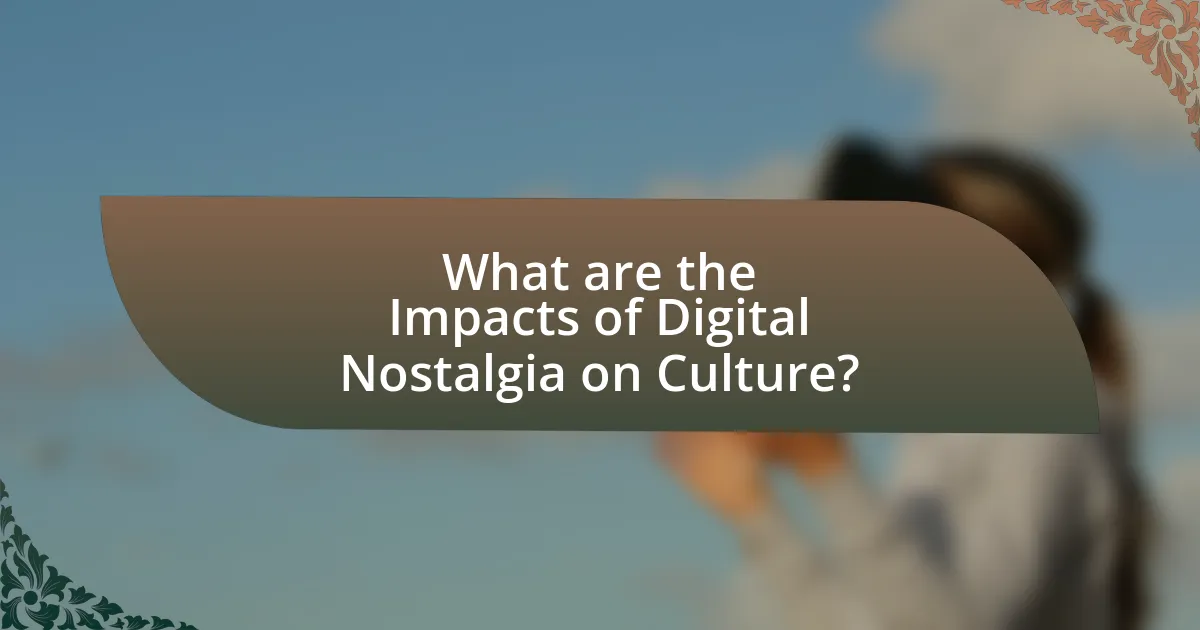
What are the Impacts of Digital Nostalgia on Culture?
Digital nostalgia significantly impacts culture by fostering a sense of connection to the past, influencing contemporary trends, and shaping collective identity. This phenomenon manifests through the revival of retro aesthetics in fashion, music, and media, as seen in the resurgence of vinyl records and 80s-themed events, which reflect a longing for simpler times. Research indicates that digital platforms, such as social media, amplify this nostalgia by allowing users to share and celebrate past experiences, thus reinforcing cultural memory. For instance, a study by the University of Southern California found that nostalgia can enhance social bonds and increase feelings of belonging among individuals, demonstrating its role in cultural cohesion.
How does Digital Nostalgia affect consumer behavior?
Digital nostalgia significantly influences consumer behavior by evoking emotional connections to past experiences, which can drive purchasing decisions. This phenomenon occurs as brands leverage nostalgic elements in marketing strategies, creating a sense of familiarity and comfort that resonates with consumers. Research indicates that 70% of consumers are more likely to purchase products that remind them of their childhood or earlier life stages, demonstrating the power of nostalgia in shaping preferences and loyalty. Additionally, nostalgia can enhance brand perception, as consumers often associate nostalgic marketing with authenticity and trustworthiness, leading to increased engagement and sales.
What trends in marketing leverage Digital Nostalgia?
Trends in marketing that leverage digital nostalgia include the revival of retro branding, the use of vintage aesthetics in advertising, and the incorporation of nostalgic elements in product design. Brands like Coca-Cola and Nintendo have successfully utilized retro campaigns, tapping into consumers’ fond memories to evoke emotional connections. For instance, Coca-Cola’s “Share a Coke” campaign featured classic bottle designs, while Nintendo’s re-release of the NES Classic Edition appealed to gamers’ nostalgia for 1980s gaming. These strategies are effective because they resonate with consumers’ emotional ties to the past, leading to increased engagement and brand loyalty.
How do brands use nostalgia to connect with audiences?
Brands use nostalgia to connect with audiences by evoking fond memories and emotions associated with past experiences, which fosters a sense of familiarity and comfort. This strategy often involves utilizing retro designs, classic advertising styles, or references to popular culture from previous decades, effectively tapping into consumers’ sentimental feelings. For instance, studies show that nostalgia can enhance brand attachment and increase consumer loyalty, as seen in campaigns by brands like Coca-Cola, which frequently incorporate vintage imagery and themes to resonate with their audience’s memories. By aligning their messaging with nostalgic elements, brands can create a deeper emotional bond, leading to increased engagement and sales.
What are the potential drawbacks of Digital Nostalgia?
Digital nostalgia can lead to several potential drawbacks, including the risk of idealizing the past, which may distort present realities. This phenomenon often results in individuals overlooking current advancements and societal progress, leading to a stagnation in innovation and cultural evolution. Research indicates that excessive engagement with nostalgic content can contribute to feelings of dissatisfaction and disconnection from contemporary life, as individuals may become overly focused on past experiences rather than embracing current opportunities. Furthermore, digital nostalgia can create a false sense of community, where individuals feel connected to a past that may not accurately reflect their lived experiences, potentially leading to social isolation in the present.
How can excessive nostalgia hinder cultural progress?
Excessive nostalgia can hinder cultural progress by creating a preference for past ideals over contemporary innovation. This fixation on previous cultural elements can stifle creativity and discourage the exploration of new ideas, as individuals and societies may prioritize preserving traditions rather than adapting to current realities. For instance, research indicates that nostalgia can lead to resistance against change, as seen in various cultural movements that romanticize historical periods while neglecting pressing social issues. Consequently, this backward-looking mindset can impede the evolution of cultural practices and limit the potential for societal advancement.
What are the risks of idealizing the past through Digital Nostalgia?
Idealizing the past through Digital Nostalgia poses several risks, including the distortion of historical accuracy and the potential for social disconnection. When individuals romanticize past experiences, they often overlook the complexities and challenges of those times, leading to a skewed perception of history. This can result in a collective memory that is overly simplistic and fails to acknowledge significant social issues, such as inequality or injustice, that were prevalent in those eras. Furthermore, excessive engagement with nostalgic content can foster a sense of disconnection from the present, as individuals may become more focused on an idealized past rather than addressing current realities and challenges. Studies indicate that nostalgia can evoke feelings of longing that may hinder personal growth and adaptation to contemporary life, reinforcing a cycle of dissatisfaction with the present.
What practical steps can individuals take to engage with Digital Nostalgia positively?
Individuals can engage with Digital Nostalgia positively by actively participating in online communities that celebrate past cultures and technologies. These communities often share content such as vintage games, retro music, and classic films, allowing individuals to connect with others who share similar interests. Engaging in discussions, sharing personal stories, and creating content inspired by nostalgic themes can enhance the experience. For instance, platforms like Reddit and Facebook host groups dedicated to specific eras or interests, fostering a sense of belonging and shared appreciation. Additionally, individuals can curate personal collections of nostalgic items, such as memorabilia or digital archives, which can serve as a tangible connection to the past. This approach not only promotes personal reflection but also encourages social interaction, reinforcing the positive aspects of Digital Nostalgia.
